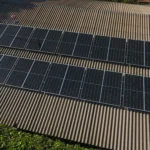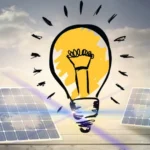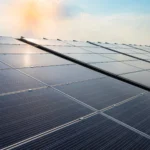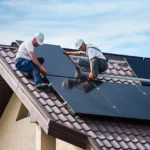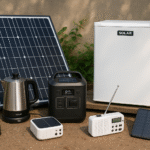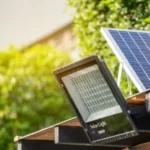Imagine your solar system waking up with the sun, adjusting itself for peak efficiency, and diverting excess power to your EV charger automatically. That’s not science fiction. That’s solar automation.
As energy prices rise and environmental concerns mount, homeowners and small business owners are seeking smarter, more self-sufficient energy solutions.Automation combines traditional photovoltaic systems with smart technology, transforming passive panels into intelligent, responsive systems.
In this guide, we’ll explore what automation means, how it works, who it’s for, and what kind of performance you can expect.

What Is Solar Automation?
At its core, automation refers to the integration of automated systems—such as smart inverters, energy management software, connected batteries, and IoT devices—into a solar energy setup. These systems optimize power production, usage, storage, and distribution without constant manual oversight.
Key Components of a Solar Setup
- Smart Inverters that regulate and report real-time power output.
- Solar Batteries with automated charge/discharge scheduling.
- Energy Management Systems (EMS) that monitor, analyze, and automate energy flows.
- Smart Thermostats, Lights, and Appliances powered directly from solar reserves.
- EV Chargers that adapt charging speeds based on panel output or time-of-use rates.
Why Automation Matters More Than Ever
Solar panels watt are efficient, but not intelligent on their own. You can generate 10 kWh of solar energy, but without proper automation, most of it could be sent back to the grid or lost due to inefficiency.
Solar automation solves this problem by ensuring that your solar energy is:
- Used where it’s needed most
- Stored when excess is available
- Shifted to appliances and EVs at off-peak hours
- Managed remotely and automatically
Homeowner Example:
Lisa, a homeowner in Phoenix, installed a 6.4 kW solar panel system with a Tesla Powerwall and a smart inverter. After adding an EMS and automating her thermostat and water heater, her electric bill dropped by an additional 20%. “I didn’t realize how much energy we were wasting during the day,” she said. “Now, our home thinks for us.”
Smart Inverter Automation: Your System’s Brain
Think of a smart inverter as the brain of your system. It doesn’t just convert DC to AC it monitors your energy production, usage trends, and can even isolate your home from the grid during outages.
Troubleshooting Tip:
If your smart inverter shows erratic behavior such as voltage fluctuations or frequent shutdowns start by:
- Checking firmware updates via the manufacturer’s portal.
- Monitoring temperature: Excessive heat can trigger shutdowns.
- Reviewing error codes via your EMS dashboard.
Some brands like SMA and SolarEdge now offer AI-driven analytics that predict faults before they occur, minimizing downtime.

Automation for EV Charging: Smarter Driving Starts at Home
If you’re charging your EV with solar, timing is everything. Many solar owners plug in as soon as they arrive home, when solar output is at its lowest. Automation solves this.
How It Works:
- Your EMS syncs with the EV charger.
- It schedules charging during midday hours (when solar output peaks).
- It adjusts the current based on real-time production.
- If cloudy weather is forecast, it defaults to off-peak night rates.
Small Business Case:
A delivery company in Miami installed eight EV chargers and a 20 kW solar array. By automating charging to run during high-output windows, they cut fuel/electric costs by 38% in 6 months.
Solar Battery Automation: Never Waste a Sunny Day
A solar battery becomes 2x more valuable when paired with automation.
Rather than charging and discharging based on fixed rules, automated battery systems:
- Store excess when production is high.
- Release stored energy during peak utility rates.
- Adjust cycles based on usage history and seasonality.
According to EnergySage, homes with optimized battery automation see an average 12–15% higher savings than homes without it.
Cleaning, Soiling Loss & Performance Monitoring
Even the smartest system suffers if your panels are dirty. On average, soiling losses can reduce panel output by up to 20%, especially in dry, dusty areas.
Best Practices for Cleaning:
- Clean panels every 3–6 months (or more frequently in pollen-heavy regions).
- Use deionized water and a soft-bristle brush.
- Avoid high-pressure washers or harsh detergents.
Automation Bonus:
Some high-end solar automation platforms (like Enphase Enlighten) alert you to performance dips caused by panel dirt, shading, or system faults—before you even notice a spike in your bill.

Remote Monitoring & Smart Notifications
With the rise of cloud dashboards and mobile apps, users can now:
- View real-time production/consumptio
- Receive fault alerts
- Get maintenance reminders
- Change appliance scheduling with one tap
Many platforms, such as Growatt’s ShinePhone or Fronius Solar.web, also offer daily, weekly, and monthly reports perfect for both tech-savvy homeowners and small business managers.
Limitations and Considerations
Automation is powerful, but not without its challenges:
| Challenge | Consideration |
| Upfront Cost | Smart inverters and EMS systems can add $1,000–$4,000 to a project |
| System Complexity | More components = more points of failure if not properly installed |
| Compatibility Issues | Not all brands play nicely together—choose a certified installer |
| Learning Curve | Some interfaces can be clunky or overly technical for casual users |
That’s why working with an experienced solar integrator is critical. According to NREL, systems with professional-grade automation setups see higher long-term ROI and fewer support tickets.
Off-Grid Solar Automation: Self-Reliance Perfected
For rural homes,solar water sprinkler, cabins, or mobile businesses, off-grid automation ensures full control.
What You’ll Need:
- Solar panels (with a minimum 3kW output)
- Battery bank (e.g., 10–20kWh lithium systems)
- Hybrid inverter
- MPPT charge controller
- EMS for load balancing
- Backup generator automation (optional)
Off-Grid Tip:
Select automation system that incorporates weather forecasting to optimize battery storage needs during low-production periods. Victron and Schneider Electric are leaders in this space.

Final Thoughts:Automation Is the Next Big Leap
Whether you’re a homeowner trying to reduce energy bills or a business owner managing multiple properties, solar automation unlocks smarter energy use, better savings, and longer system life.
If you already have solar, automation may be your next best upgrade. And if you’re new to solar, designing your system with smart tech from day one will pay dividends in the long run.
Ready to Maximize Your Solar Potential?
If your panels haven’t been cleaned in over 3 months, or if your system doesn’t respond to your daily habits, you could be leaving savings on the table. Schedule a solar performance checkup today and find out how automation can elevate your energy game.




